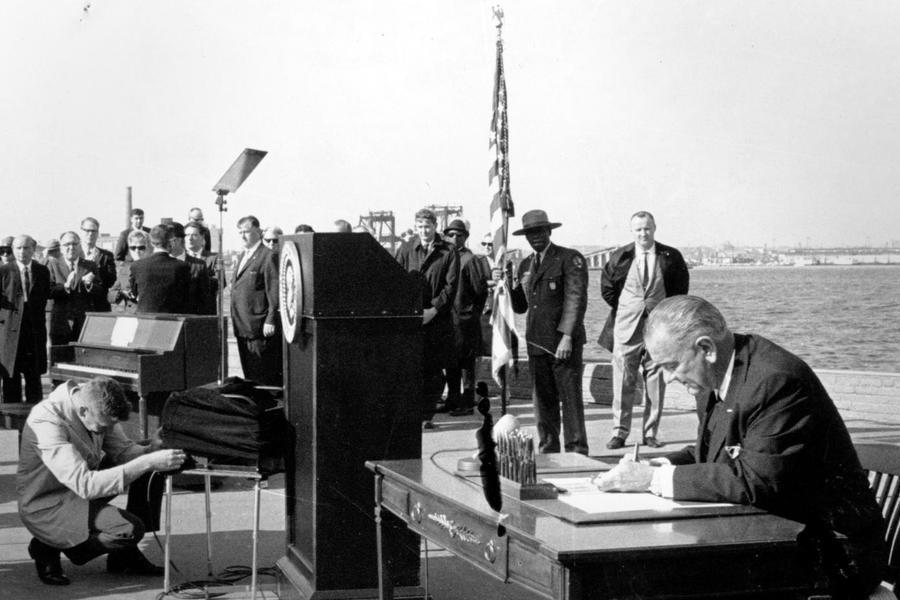Radical Overhaul and Unintended Consequences

Wikimedia CommonsPresident Lyndon Johnson signs the Immigration and Nationality Act at Ellis Island on October 3, 1965.
The quota system ran into its first crisis within a decade. The rise of fascism in Europe, specifically of anti-Semitic regimes such as the Nazis, created a human rights disaster that sent hundreds of thousands of Jews and political refugees scrambling for the boats.
Heedless of the real danger, Congress refused to significantly raise the quotas for immigration from Germany, Italy, Spain, and Poland, instead treating Jewish refugees from these countries as if they didn’t have any special reason to seek asylum in America.
By the time war broke out, it was already too late to make major changes or to accept the few refugees who could still book passage, though a 1943 amendment repealed the Chinese Exclusion Act. This was mostly a symbolic gesture toward an ally; no significant effect was felt while the Japanese Navy stood between would-be immigrants and the safer shores of the United States.
In 1948, the system was updated to make immigration easier for American war brides and to accept political refugees, this time fleeing Communist regimes.
In 1952, during the second Red Scare, immigration law got another major overhaul. Going forward:
The 1960s then saw drastic changes in immigration policy.
Opponents of the quota system decried the national origins system as a relic of the bad old days of institutional racism and agitated for reform. In 1965, Congress passed a radical change. It abolished the national quotas, though hemisphere caps were left in place, and a virtual green light was given to families of current legal residents.
This latter clause created a daisy chain effect, in which a single person could legally enter the United States and then fast-track in almost any number of his or her family members, and so issuing a single green card might lead to a dozen more over the next year or two.
Proponents of the 1965 act swore to the public that the changes wouldn’t significantly affect the demographics of the United States, but data show that isn’t exactly the case. Between 1790 and 1960, 90 percent of Americans reported themselves as “White” on the Census. In 1960, for example, only 0.9 percent of Americans identified as anything other than White or Black. In 1970, Asian/Pacific Islander and Other were 1.4 percent. In 1980, they were 5.2 percent. In 1990, 7.7 percent. In 2000, counting people who claimed Two or More Races, the figure was 12.5 percent.
Native Unease and Big, Beautiful Walls

Justin Sullivan/Getty Images
Much of this increase had to do with a new category of immigrant: Diversity. Prior to the 1990-1995 revisions, preference had always been given to skilled workers and family members, but the new system gave almost identical preference to “historically underrepresented” groups.
In a bizarre reversal of history, racial quotas have reappeared in American immigration policy, this time running in the opposite direction and favoring immigrants from countries the United States had historically tried to keep out, such as Somalia and Sudan.
These Diversity admissions are a wedge that has inflamed the national debate over immigration for 20 years (and counting), as opponents of the policy see in it a sinister plot to reduce the white majority for political and philosophical reasons they never voted for.
These tensions came to a head during the 2016 presidential election, when candidate Donald Trump promised to build a “big, beautiful” wall on the border with Mexico. Technically, this has nothing to do with immigration policy, as the debate has been focused on illegal immigration, and Trump claimed in an interview that he was willing to build a “big, beautiful” gate in the wall to admit people legally. But many voters also approved of his promise to bar immigration from Muslim-majority countries and to – once again – overhaul immigration law.
As of this writing, it remains to be seen where the new president’s policies will go, and to what extent immigration law will change during his term.
Next, see what life was like for immigrants arriving on Ellis Island, and what awaited them after their arrival.





